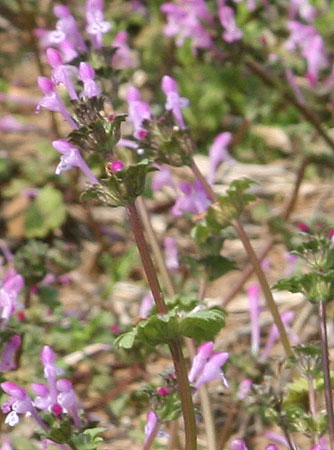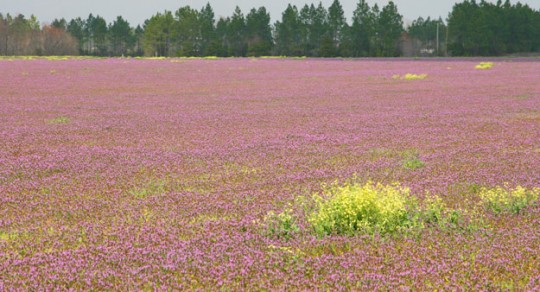Sea Of Purple: What’s That Purple Flower That’s Everywhere Called?
March 2, 2011
 Ever wonder what the name of that that purple flower is that is blooming everywhere in North Escambia, often turning entire fields (or the corner of a neighborhood yard) into a sea of purple?
Ever wonder what the name of that that purple flower is that is blooming everywhere in North Escambia, often turning entire fields (or the corner of a neighborhood yard) into a sea of purple?
We posed the question to UF IFAS Escambia County Extension Agent Libbie Johnson and found out it’s called henbit (or more scientifically, Lamium amplexicaule):
Henbit is a cool season, annual broadleaf weed that germinates in the fall and continues to grow throughout the winter and spring. In some of Escambia County’s agricultural fields, it is currently one of the dominant species present.
Henbit is a member of the mint family. If you take a good look at it, you can see that it has square, slender stems. The stems can root at the lower nodes. Leaves are opposite, nearly circular, deeply veined, hairy and petioled. This isn’t a deeply rooted plant—roots are shallow and fibrous. The tubular flowers are generally purple to pink in color.
“Like most plants, the best control is achieved before the plants start to flower. Herbicides work better if you can spray when the plants are small and immature, but with the cold winter, scouting planted pasture for weeds may not have been on the top of the list of activities. For many, no control of henbit is necessary. Contact your local Extension agent to determine which herbicide would work best for your particular cropping system,” Johnson said.
Pictured: A sea of purple is formed by henbit in a field along Highway 97 at Tungoil Road in Walnut Hill.
Comments
17 Responses to “Sea Of Purple: What’s That Purple Flower That’s Everywhere Called?”




Leaves of Henbit are edible, and also can be used for herbal medicine. A good salad using it can be found in “Backyard Nature” (a google group).
Beautiful little weeds! I always love to see them growing along the roadsides and always think of Lady Bird Johnson and her ideas of letting wild flowers grow and seeding even more along the highways in Texas as a way to help beautify the state.
Allergies? Eat more local honey!
Anyone else having their allergies going bananas? I know mine are.
Wow I learn something new. Thanks this is good information at least now I know what they are called I had wondered a long time and when I ask no one seem to have known.
thanks, gerry
I wish my yard were covered in this! So pretty! I would love to try some of this honey!
Mr. Green
The green ones are wild turnips.
REGARDING:
“Does your yellow flowering plant have 5 leaves?”
I’m talking about the ones in the top picture. I’m seeing them in fields all over the place, but I haven’t pulled the bus over to go check them out. (The school system tends to frown on such excursions–sounds like a cheap field trip–especially if they’re weeds.)
David with daffodils, hawthorns,
peach blossoms, wisteria getting ready to bloom,
smelling the chestnut tassels, and lots more
LOL…William, let me know when you want to come over and mow!
>>My entire front yard in Pensacola is covered with this! It was not there last winter. Could it be that when I threw out grass seed last year, this was in it or is it just a natural occurence? Any help would be greatly appreciated!
If you add plenty of dandelions, the yellow looks really good with the purple and you don’t need to mow. Tell the neighbors you’ve gone natural and green.
My entire front yard in Pensacola is covered with this! It was not there last winter. Could it be that when I threw out grass seed last year, this was in it or is it just a natural occurence? Any help would be greatly appreciated!
DHG,
Does your yellow flowerng plant have 5 leaves?
now tell us about the yellow flowered plants too. They remind me of mustard but some days everything reminds me of mustard. (especially if greens are boiling)
Beautiful!!! I love wild flowers and some flowering weeds. As long as they don’t harm the crops let the bees have them to do what they do best, make that delicious honey!
They may be just weeds, but they’re beautiful after a long brown winter and apparently useful too. Who doesn’t love honey…
This plant makes very good honey and has a purple color to it when the bee’s feed on it.
Just a little more unfo on these pretty lille flowers, especially for all those who like local honey…these little flowers are a favorite to honey bees, and play a huge role in them coming out after winter so they can start preparing for the first honey flow of the year. Even if honey isn’t something you like, honeybees also play a huge role in most crops producing…they are a farmer’s friend~some actually pay to have hives put on their property to help with pollination of their crops! So asking as a local honeybee care taker… if the flowers aren’t interfering with anything, please think before just spraying.